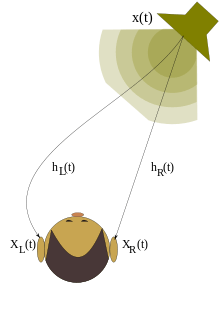
Head-related transfer function
A head-related transfer function (HRTF) is a response that characterizes how an ear receives a sound from a point in space; a pair of HRTFs for two ears can be used to synthesize a binaural sound that seems to come from a particular point in space. It is a transfer function, describing how a sound from a specific point will arrive at the ear (generally at the outer end of the auditory canal). Some consumer home entertainment products designed to reproduce surround sound from stereo (two-speaker) headphones use HRTFs. Some forms of HRTF-processing have also been included in computer software to simulate surround sound playback from loudspeakers.
Humans have just two ears, but can locate sounds in three dimensions – in range (distance), in direction above and below, in front and to the rear, as well as to either side. This is possible because the brain, inner ear and the external ears (pinna) work together to make inferences about location. This ability to localize sound sources may have developed in humans and ancestors as an evolutionary necessity, since the eyes can only see a fraction of the world around a viewer, and vision is hampered in darkness, while the ability to localize a sound source works in all directions, to varying accuracy, regardless of the surrounding light.
Podcasts:

-
by Wrethov
-
by Wrethov
-
by Redfoo
-
by Redfoo
-
by Redfoo
One Love One Goal
by: WrethovAs long as I remember
Never have I surrendered
Never said die I stand here
One love one goal
And I'll never give up, never give in. oh no!
Cuz we gotta belive
And I will never stop, fighting to win! come on!
Let's make tonight last forever
Cuz all of us know
It's one love oh oh
One love, one goal!
N' share this moment together
And never let go
We're singing
One! - hey!
Love! - hey!
One love one goal!
I've lost far too many
Times but deep inside me
Hides a great destiny
One love one goal
And I'll never give up, never give in. oh no!
Cuz we've gotta push thru
